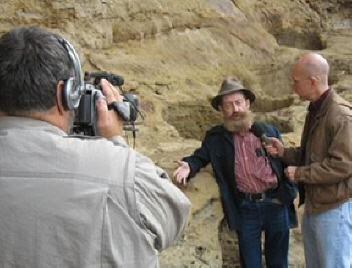WHERE THE OSAGE WALKED
By Colette Lefebvre-Davis
The Sunday Herald-Tribune
Nevada Daily Mail
Thursday, November 16, 2006
Patrick Brophy, the director of the Bushwhacker Museum has written much on the Osage in Vernon County. That is why he was chosen to be interviewed on Tuesday afternoon.

Local historian Patrick Brophy, center, discusses Osage cache pits with Tim Gore and Jim Sturm, near Halley's Bluff in northeastern Vernon County, for a documentary film about the area
But, this wasn't just any interview, Brophy, his constituent Terry Ramsey and two educators met on M Highway, and caravaned out to Halley's Bluff which is on property owned by the Church of Israel, located near Schell City. Tim Gore is the education director for the Round Trips Interactive video video learning project, he is joined by his partner Jim Sturm.
Gore was a teacher in Nevada, Mo., from 1981 to 1993, where he then moved to the St. Louis area and taught speech and debate for the Clayton County school district. Sturm and Gore are both middle school teachers, Sturm was a teacher of science and mathematics. Ramsey, introduced the crew to the Rev. Dan Gayman and laid out her itinerary. The first area that the group hit were the bluffs. Strum stopped, turning on his camera, getting a panoramic shot of the Osage River below the peaked bluffs.
The November day was bright, sunny and autumnal. Ramsey, led the group to the cache pits below what was Fort Carondelet in the late 18th century. There Gore began to interview Brophy, about the pits themselves, their purpose and even the gradations of the limestone rock. The caches have changed a bit since they were in use -- they are now carved and eroded away.
Historians estimate that at one time there were more than 23 cache or storage pits at Halley's Bluff, but now there are less than 10. Brophy explained that these pits might have been developed to store furs for the trappers who moved up and down the Osage River during that time. Fort Carondelet was built in 1794 by Auguste Choteau who proposed to the Spanish officer Baron Carondelet that he would build a fort as protection from the Osage in return for a great amount of monopoly of the fur trade. Since the proposition required no expenditure of money on the part of the Spanish, Carondelet agreed.
Brophy then took the group past a break in the boulders that served as an quick access to the caches from the fort above, now long since shifted, with the rocks having moved in closer to the crack. Ramsey took the group to the top of the bluffs where Brophy began to explain to the crew about archeological excavations that had taken place on the site of what was Fort Carondelet.
"All they found were post hole evidence, so then they gathered that the stockade lay about here." explained Brophy as his arms swept across the front of the view. Brophy explained that deterioration from the original oak fortifications was found by Dr. Chapman's archeological crew in the 1960's. Gore and Strum took some last shots of the area and then it was off to Blue Mound the traditional burial place of the great Osage chief Pawhuska or "white hair." He is so named, it is told, that during a battle in the Ohio river valley a young warrior went to scalp his victim, and without need of a knife the victim's hair came off. It was a powdered wig, but forevermore, the young warrior donned the wig and as tradition holds he was formally called Pawhuska. The grave is gone and long since forgotten by the Osage people.
Brophy remembers that his father had told him that as a child, on the way to blue mound, Osage Indians would camp by the roadsides, on a pilgrimage of sorts to the traditional grave of Pawhuska. According to Brophy, there isn't any evidence on the mound, only tradition.
After visiting the site, the group moved on to Truman Elementary School in Nevada, where Strum and Gore checked in with the fourth grade class.
The educational program is geared towards fourth graders, "the children from one area share their county with other fourth graders in the rest of Missouri." explained Gore.
Nevada's fourth graders are presenting famous Missourians, which include the Hornbacks, Jessie James, Virginia Alice Cottey, Harry S. Truman, and William Joel Stone. This isn't the first project for Gore and Strum, the pair worked with the National Park service to generate educational footage for the Lewis and Clark Centennial. "This project if focused on Missouri's regions, it's time tell their story. It is designed so that they can share targeting topics." explained Gore.
Ramsey and the two visitors are excited about the upcoming program. Students from area schools will be able to view and participate in the program via the Web and video teleconferencing. According to Gore, the schools jumped on board as soon as they caught wind of the opportunity. And, as Gore states, "it's a way to show the kids the applications of subjects and the history of the state."
Return to Halley's Bluff
Return to Towns and Townships
Please contact the County Coordinator if you have family information or photos that can be displayed on this page.
This information is provided for use in your personal family history research. Do not copy this information and publish elsewhere on the internet, post on other websites, or in blogs without the express written consent of the County Coordinator.
Links to web sites that are not part of the USGenWeb Project are provided for your convenience and do not imply any endorsement of the web sites or their content by The USGenWeb Project.
Missouri State GenWeb Coordinator Asst. State Coordinator
site search engine by freefind
© 2000-2025 Vernon Co, MO County Coordinator, N. Carroll, County Coordinator


